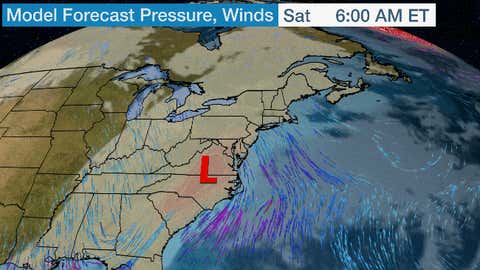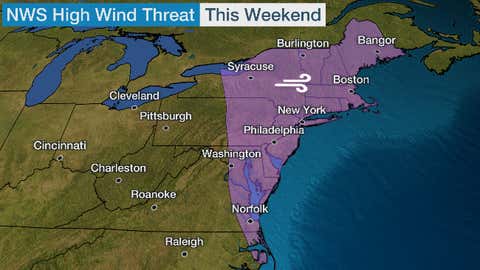A potent winter storm will spread snow from parts of the Midwest and South into New England, then turn into a "bomb cyclone" packing high winds as it tracks into Canada.
This weather system has been named Winter Storm Quinlan by The Weather Channel.
The setup for this storm began with a potent blast of cold air surging south out of Canada into the Plains and Rockies.
A pair of strong jet streams will spin up low pressure along a cold front in the lower Mississippi Valley, then intensify as it races into the Northeast Saturday and eastern Canada by Sunday.
The area of low pressure is expected to become a "bomb cyclone" by the time it reaches New England or Atlantic Canada. We'll have more about that aspect of the forecast after first discussing the expected snow.
Winter weather alerts have been issued by the National Weather Service along the path of the storm, including areas from the Appalachians into the Northeast.

A band of snow from this storm is ongoing right now in an area that stretches from eastern Tennessee to the mid-Atlantic and the interior Northeast.
More than 8 inches of snow has fallen in the Appalachians so far, with St. Albans, West Virginia picking up 9 inches of snow. Knoxville, Tennessee, Pittsburgh, Pennsylvania and Buffalo, New York have picked up 6-7 inches.
So far, the heaviest snow totals outside of the high country of the Rockies have been in parts of western Kansas, where more than a foot of snow has piled up in some locations. Anywhere from 2 to 5 inches of snow fell in the Kansas City metro Thursday.
Oklahoma City picked up 2 to 3 inches, while Tulsa tallied up 3 to 4 inches of snow Friday. This band of generally 2 to 5 inches of snow stretched northeastward through central Illinois, northern Indiana and Lower Michigan.

Here's a breakdown of the timing, snow forecast and wind threat from Winter Storm Quinlan.
Storm Timing
Saturday
Wind-driven snow, heavy at times, is expected Saturday from the Appalachians into the interior Northeast.
Closer to the Interstate 95 urban corridor, initial rain and perhaps even a clap of thunder could change to a period of wet snow Saturday or Saturday night before the precipitation ends.
The storm should depart the U.S. and head into Canada by Sunday, but cold air crashing behind the front could lead to icy roads in the Northeast into Sunday morning.

Snowfall Forecast
The heaviest snow from this storm is expected in the interior Northeast and parts of the Appalachians, where 6 inches of snow is a good bet. Some 1-foot-plus totals are possible in upstate New York and northern New England.
Elsewhere, snowfall should be fairly modest, generally less than 6 inches in most locations.
However, those snow accumulations could still make for slippery travel, particularly in the South.
Around an inch of snow is possible along the Interstate 95 corridor from the New York City tri-state area south to Philadelphia, Baltimore and Washington, D.C. Somewhat higher totals are possible on the north and west sides of these metro areas.

Bomb Cyclone Forecast
As alluded to earlier, computer forecast models suggest low pressure will explosively develop along the cold front Saturday in the East, and continue doing so into eastern Canada Sunday.
It is likely to exceed the criterion to be deemed a "bomb cyclone" by the time the low moves into Atlantic Canada, meaning its minimum surface pressure will drop at least 24 millibars in 24 hours or less.
You can see this in the model forecast loop below.

In general, lower pressure means a more intense storm, especially when it comes to the strength of the winds it can unleash.
High winds are possible Saturday into early Sunday in parts of the East, possibly as far south as the coastal Carolinas, extending into New England.
This threat is highest along the immediate coast ahead of the front Saturday, as well as over the higher terrain of the Northeast. At least some downed tree limbs and power outages are possible in these areas.
Strong winds combined with snow could lead to reduced visibility and dangerous winter driving conditions in the areas of the interior Northeast, where accumulations are expected this weekend. Keep this in mind if you have travel plans.

Damaging winds are also possible this weekend in parts of eastern Canada, including Nova Scotia, New Brunswick, Newfoundland and Labrador. According to Environment Canada, wind gusts up to 85 mph are possible over the most exposed coastal or mountain locations of Newfoundland overnight Saturday night into Sunday.
In fact, the strength of the bomb cyclone as forecast by some computer models could flirt with all-time low-pressure records in eastern Canada, according to data compiled by NOAA meteorologist David Roth.
According to Roth, these existing records are generally in the 950-959 mb range in Nova Scotia, New Brunswick and eastern Québec, and in the 940s in much of Newfoundland and eastern Labrador.
